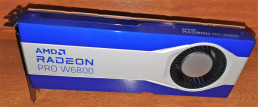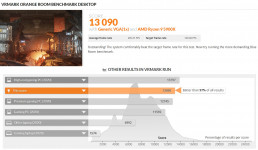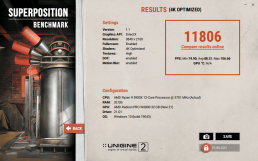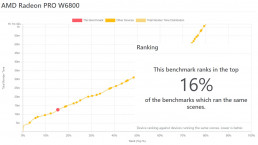In early June 2021, AMD announced the AMD Radeon PRO W6000 series workstation graphics, designed and optimized to power demanding architectural design workloads, ultra-high resolution media projects, complex design and engineering simulations, and advanced image and video editing applications. The new professional product line features the AMD Radeon PRO W6800, which is the most powerful AMD RDNA2 workstation graphics card, according to the company — and the subject of our review.
Specifications and Features
The AMD Radeon PRO W6800 graphics card is powered by RDNA 2 architecture and features 32GB of GDDR6 ECC memory, hardware raytracing, and support for up to six demanding 4K UHD HDR displays, provided directly through six Mini-DisplayPort 1.4 with Display Stream Compression (DSC). The GPU packs 26.8 billion transistors in 7 nm process, 3,840 stream processors, and 60 compute units.
RDNA2, in short, is really engineered from the ground up to enable many compute units to cooperate as a workgroup processor. It has a redesigned SIMD architecture and multilevel cache hierarchy, for faster execution of large work groups, latency reduction, lower power consumption, and minimal data movement. RDNA 2 architecture provides a major on-chip cache uplift of 128MB. This larger cache, which AMD has dubbed “Infinity Cache,” improves efficiency and performance by reducing the frequent access to video RAM (VRAM). In addition, AMD added a Ray Accelerator hardware component to every compute unit to enhance the ray tracing process and performance. This specialized hardware handles the intersection of rays directly on the Radeon PRO W6800, making it AMD’s first professional card to feature accelerated hardware raytracing.
AMD takes what it refers to as “security by design” seriously. For example, the company integrates dedicated security hardware into the GPU, to create a foundational layer of graphics hardware security, acting as a hardware root of trust. This security feature is useful for the Radeon PRO W6800 users, especially companies dealing with sensitive data and designs, as well as for use cases like remote access, virtualization, and defense designs and simulation.
Benchmark System
Our test system combined the AMD Ryzen 9 5900X and Radeon PRO W6800 with a 32GB DDR4 3600MHz CL14 RAM kit, a 500GB M.2 Gen4 NVMe SSD, and an AMD B550 ATX motherboard. This system reflects a realistic mid-range build similar to what a content creator or an engineer would assemble for a system-integrated productivity PC.
Synthetic Benchmarks
PCMark 10 features a comprehensive set of tests that cover the wide variety of tasks performed in the modern workplace. The tasks tested include web browsing, videoconferencing, spreadsheet and word-processing workloads, photo and video editing, and rendering and visualization. The 7,735 score the platform achieved was better than 99% of all results.
VRMark Orange Room benchmark was a test for the Radeon PRO W6800 against the requirements of HTC Vive and Oculus Rift, the two most popular VR systems. This is important for VR software and content creators, who are mostly using gaming graphics cards, even with brand workstations, since they are at the price of entry-level professional cards and achieve results on par with high-end pro cards, which are four times more expensive. A good VR performance from the Radeon PRO W6800 means that VR companies and creators can finally consider moving away from gaming cards, whereas the extra cost is justified by stability, manageability, and support. With a score of 13090, the system performed 43% better than a previously tested workstation system featuring a Ryzen 2nd Gen Threadripper 2990WX processor and a Radeon Pro W5700 graphics card, and better than 97% of all results. The most demanding VR benchmark, in 5K rendering resolution (5120 × 2880), is the VRMark Blue Room. This time the test system’s result was better than 82% of all results, an impressive performance against a challenging resolution.
Superposition benchmark is powered by a UNIGINE 2 Engine, with unique Screen-Space Ray-Traced Global Illumination (SSRTGI) dynamic lighting technology and over 900 interactive objects. The Radeon PRO W6800 system score was 11,806 in the 4K optimized test, which was 87% higher than the Radeon Pro W5700 system and competitive with the gaming-optimized consumer-focused Radeon RX 6800 XT’s score of 14,275.
We also pushed the card to its RAM limits with the 8K test, which was run at an average of 36FPS and a minimum of 31FPS. This was an excellent result for this crazy intensive resolution, thanks to the card’s copious amount of VRAM.
Productivity Benchmarks
Realbench uses open-source applications (such as GIMP for image editing, Handbrake h.264 for video compression, and LuxMark for rendering) to simulate real-world performance. The test platform achieved a final score of 258,569, which was 37% higher than the Radeon Pro W5700 graphics card system. The rendering performance, based on LuxRender — an unbiased rendering engine that simulates the flow of light according to physical equations— was 78% faster.
In addition, we used Blender benchmark to test the rendering performance of the professional graphics card, which took 13 minutes to accomplish. This result ranks in the top 16% of benchmarks running the same scene, which shows the Radeon Pro W6800 again stretching beyond the midrange results, to reach closer to the top 10%.
For digital content creation, we used PugetBench for Premiere Pro benchmark, which looks at both live playback and export performance with a wide range of codecs at 4K resolution. Dedicated heavy GPU effects and intensive CPU effects sequences are included to individually stress the GPU and CPU beyond what a typical Premiere Pro user will do. The test platform achieved a standard overall score of 831, which was 12% higher than a similarly configured system from Puget results’ data base but powered by a Radeon Pro W5700 graphics card.
Finally, but most importantly, comes the SPECviewperf 13 benchmark, which is one of the industry’s standards for measuring graphics performance based on professional applications with real workloads from prominent ISVs — such as 3ds Max 2016 from Autodesk, Creo 3 and Creo 4 from PTC, and NX 8.0 from Siemens. We did not use the latest release, the SPECviewperf 2020 benchmark, since we no longer have access to the Radeon Pro W5700, which we tested at the time with SPECviewperf 13 benchmark.
The results showed a massive generational leap, most notably in 3ds Max, with nearly double the performance and more than 40% performance gain in most tests. That said, the Radeon Pro W5700 was powered by an AMD Ryzen Threadripper 2990WX processor, which means the increase in performance might be even bigger with a similar pro platform.
Gaming
Until recently, gaming used to be next to impossible on professional graphics cards. Those cards are built for stability and accuracy, which means running at lower GPU and RAM frequencies than gaming cards, to control power consumption and temperature.
The situation is improving, as the manufacturing process is getting more efficient. Resulting professional GPUs run cooler, thus giving headroom for higher operating frequencies, while VRAM is getting as fast as gaming modules and even larger in size.
Gaming is also becoming an important workload for professional graphics cards, not as a use case for a creator/engineer/developer by day then gamer at night, but a necessity for developing 3D and VR games, in addition to accelerating game engines – like Unreal Engine and CRYENGINE, some of which are even used in architectural and open world visualization. A prime use case for this new application is in virtual film sets. On The Mandalorian from Disney+, for example, digital “volume” creates a seamless virtual world to extend the set and allow expansive and realistic shots without the need for location-based filming or expensive 3D modelling and lighting. This needs incredibly accurate rendering, adhering to the laws of physics.
The Radeon Pro W6800 test platform achieved an average of 69 frames per second (fps) running Shadow of the Tomb Raider at 1440p and the highest graphical settings in ultra-raytraced shadow quality. Dirt 5 was running at 100fps with similar settings at the same resolution.
AMD FidelityFX Super Resolution is AMD’s latest cutting-edge upscaling technologies to help boost framerates and deliver high-quality, high-resolution gaming experiences. It works with the Radeon Pro W6800. We got 20% more frames in 1440p with epic settings in Godfall and Terminator Resistance just by using FSR in Ultra Quality. There was no visible difference in visual quality. This is a noticeable gain in performance, especially in a raytraced game like Godfall.
Machine Learning
Radeon Machine Learning is an AMD SDK for high-performance deep learning inference on GPUs. It uses a single, native, low-level API to achieve the best possible performance. Radeon ML is built with backend support from Microsoft DirectML, MIOpen, and Apple MPS, which is great for interoperability.
This means that applications taking advantage of the SDK can also leverage AI in operations like denoising images and upscaling videos. We used Video Enhance AI by Topaz Labs to upscale a five-minute music video clip, from 480p to 4K. The AI software recognized the Radeon Pro W6800 and processed the video in one hour. Upscaling the same video with the AMD Ryzen 9 5900X was projected to take 8 hours.
Such applications are popular among users who like to convert their old 720p DVD collections of serials and movies to suit their 4K TV sets. We are not sure how efficient or time-consuming such processes will be with the Radeon Pro W6800, given that it took one hour to upscale just 5 minutes in our test. But it is a step in the right direction from AMD, in a field that is of prime focus at the datacenter for the company.
IDC Opinion and Conclusion
In normal market conditions, we would conclude that AMD is pushing the limits in terms of asking price. But given the current market conditions, including chip shortages and the competition’s higher pricing schemes, we totally understand. As a matter of fact, the announced $2,250 price point is not that much higher than that of the four-year-old Radeon Pro WX 9100 upon release, whose buyers are now the perfect target customers for the Radeon Pro W6800.
There are two main challenges facing the Radeon Pro W6800. The first is the competition from gaming cards, especially in buying segments like small and medium-sized businesses, engineers, and creators that configure or build their own workstations. For this, AMD has to emphasize the importance of RAM size, especially when dealing with complex models that include millions of entities and objects, as well as 8K video editing and rendering.
The second challenge is the general view of AMD professional graphics cards as a more cost-effective alternative. End users will not become fully confident in Radeon Pro until AMD partners do. The company did well on the CPU side of things, introducing a high end Threadripper based ThinkStation model in collaboration with Lenovo. We expect AMD to position the Radeon Pro W6800 card in high-end workstation systems from prominent partners like Lenovo, Dell, and HP, as well as systems integrators like Boxx. AMD should keep in mind that the European market loves a good success story. Highlighting the high-profile use cases of the Radeon Pro W6800 by prominent companies in industries like automotive, architecture and construction, and entertainment will go a long way towards capturing mindshare.
In conclusion, AMD brings yet another new design to its professional line of graphics cards — not just a traditional enhancement over the previous generation, but a deep-down change to the architecture. The Radeon Pro W6800 is fast, the first pro card we see constantly and continuously clocking higher than the 2GHz core speed barrier, not just boosting above it for few seconds. It is AMD’s first when it comes to hardware raytracing and featuring this amount of on-chip cache and ECC VRAM size. Our test results show a serious generational leap in gains and performance. For this and other reasons, we are convinced of this card’s capabilities and have no issues with recommending it. We also look forward to AMD introducing an even more powerful card, to compete on the highest tier space.
To learn more about our upcoming research, please contact Mohamed Hefny or Andrew Buss, or head over to https://www.idc.com/eu and drop your details in the form on the top right.














